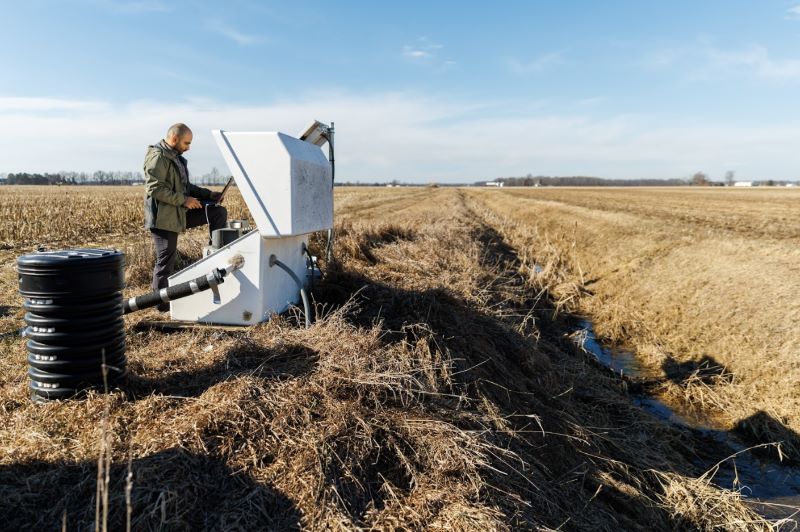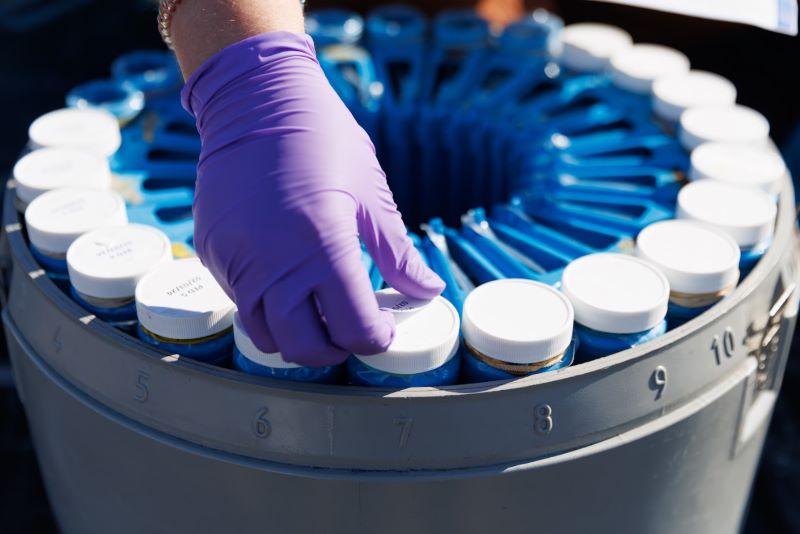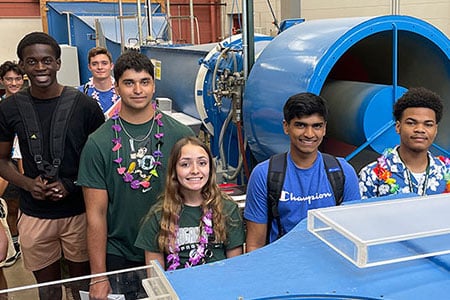
For nearly 160 years, generations of the Isley family have cultivated the fertile soil of Lenawee County, Michigan, located about 25 miles from the shores of western Lake Erie in the River Raisin Watershed.
And now they are helping Michigan State University improve the water quality and reduce toxic algae in this area.
Today, Jim and Laurie Isley, with son Jake, operate Sunrise Farms and its 1,100 acres dedicated to corn and soybeans.
The family takes pride in its stewardship of the land and farming operation, implementing no-till and strip-till systems, cover crops, filter strips and water retention structures to keep nutrients on the farm.
The Isleys made natural partners for MSU researcher Ehsan Ghane, associate professor and MSU Extension specialist in the Department of Biosystems and Agricultural Engineering.
Ghane and the Isleys are examining the effectiveness of a water management system — controlled drainage — to see how it is best implemented and how effective this system is at keeping nutrients in fields rather than draining into surrounding waterways where they can create harmful algae blooms.
Together with farmers and agricultural stakeholders across Michigan, and supported by partnerships with the Michigan Department of Agriculture and Rural Development, or MDARD, the Michigan Soybean Committee, the Corn Marketing Program of Michigan and Michigan Department of Environment, Great Lakes and Energy, or EGLE, Ghane is exploring practices he hopes will assist Michigan farmers in abiding by what he calls, “the golden rule of drainage: drain only what is necessary for crop production and not a drop more.”
Ghane and his research team recently received a $1.2 million grant extension from MDARD to continue his “Edge-of-Field” research project that began in 2018 on three farms in the River Raisin Watershed, including the Isleys’, which investigated the effectiveness of conservation drainage practices.
“Our research is conducted on privately owned farmland, and we partner closely with the landowners, farmers and producers,” says Ghane. “We share data with them, and they share their farming practices with us, so we both learn from each other. Our partnership with the farmers is a critical component of this research.”
Laurie Isley, who is a farmer director for Michigan on the United Soybean Board, says MSU’s emphasis on practical, on-field research, and allowing Michigan farmers to be part of a solutions-based approach to improving water quality is what drew her family to the project.
MSU collaborates with farmers in the area through the River Raisin Watershed Council, Michigan Farm Bureau, Conservation Districts, MSU Extension and other organizations aimed at reducing environmental impact and water quality issues in the region.
Ultimately, researchers aim to prove that drainage water can decrease the amount of nutrient runoff in fields, and additionally work with Michigan farmers to adapt those techniques to their respective environment and operations. Reducing nutrient loss on fields could also bring economic benefits to farmers in the long run.
“MSU does a great job making the science something farmers can understand and use,” says Laurie Isley. “We know not every farmer can adopt every new technique, but every farmer can do something in the way of conservation, and research like Dr. Ghane’s provides proof that these techniques will be effective.”

Reducing toxic algae blooms
For about two decades, annual algae blooms — fed primarily by phosphorus loss from sources like agricultural fields, animal facilities and wastewater treatment plants, among others — have developed in the western portion of Lake Erie.
In the Western Lake Erie Basin, blooms of blue green algae, called cyanobacteria, can produce toxins that can kill fish, mammals and birds, and can cause human illness.
According to a study by the National Oceanic and Atmospheric Administration, harmful algal blooms cause approximately $82 million annually in economic losses in fishing and tourism in the Great Lakes region.
Lake Erie has been identified as an impaired watershed, and climate change exacerbates the problem of farm pollution runoff. The Great Lakes region is experiencing more intense and sporadic rain events, leading to periods of drought followed by floods that send polluted water streaming off farm fields and into Lake Erie. Data collection by MSU from the previous five years on partner farms has shown as much as 25% phosphorus loss reduction using these drainage methods compared to control fields. Researchers believe these methods have the potential to capture even more than the initial studies indicate.
“This research allows us to understand the effectiveness of our conservation practices, how we can improve those practices and how we can play our part to reduce the potential negative impact on water quality,” Jake Isley says.
Empowering farmers to lead the way
The drainage techniques Ghane and his team are implementing have proven effective in managing nitrate losses on fields draining into the Mississippi River, says Michigan Farm Bureau Conservation and Regulatory Specialist Laura Campbell. Implementing these techniques in the Western Lake Erie Basin will provide insight into how well the same will hold true for phosphorus losses into Lake Erie.
“Phosphorus management is a crucial step forward for the protection of the Western Lake Erie Basin, and Michigan farmers are invested in making sure they do the best they can to protect water quality in their own watershed,” Campbell says.
Campbell says research of this magnitude and scope requires stakeholder engagement, and MSU plays a key role in collaborating and communicating research processes and findings with farmers, state and federal agencies, commodity advocates and other stakeholders to ensure the information is available and applicable to farms and fields throughout the region and the state.
The Isleys’ son Jake and his wife LeeAnn represent the future of Sunrise Farms, and participating in research like Ghane’s “Edge-of-Field” project provides foundational data to help them continue to adapt and implement practices into their operations that produce environmental benefits.
“If we didn’t have Dr. Ghane’s monitoring station, we could say all these systems make sense and we think these practices will have an impact, but unless we do the testing, we really don’t know. This provides clarity on the practices we’ve started and the system we’re building,” Jake Isley says.
Learn more about MSU’s solutions for a changing environment here.
Story courtesy of Justin Whitmore, MSU Today





